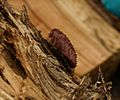Slime mould facts for kids
Slime moulds are amazing living things found all over the world, especially on the floor of rainforests. They look a bit like jelly or goo and slowly slide over the ground and fallen tree trunks. They are always searching for food!
Even though they are called "moulds," they are not actually fungi (like mushrooms). Slime moulds are very unique because they can act like tiny, single cells for part of their lives. But then, when they need to, they can come together to form a larger, multicellular group that moves and makes spores. This means they are both single-celled and multicellular!
When they come together, their cell walls disappear, and they become a "plasmodium." This is like one big blob with many nuclei (the control centers of cells) inside, but not many separate cells. This blob can move around and eat bacteria and other tiny food bits.
When food becomes scarce, the plasmodium makes special cells that turn into spores. These spores are then released from a structure that looks a bit like a tiny seed pod. These spores can then grow into new slime moulds, starting the cycle all over again.
What are Slime Moulds?
Scientists used to think slime moulds were a type of fungus. But with modern molecular biology (which looks at tiny parts of living things), we now know they are not all closely related. They are actually split into three different main groups, and none of them are true fungi! They are grouped together because they share some similar ways of living.
Different Types of Slime Moulds
There are several interesting groups of slime moulds:
- Bikonts: These are cells that have two whip-like tails called flagellae. Some slime moulds in this group are:
- Acrasidae: These are a type of slime mould found in a larger group called Excavata.
- Labyrinthulomycetes: These are also called "slime nets." They live in the ocean and create amazing maze-like tubes where their amoeba-like cells can travel.
- Phytomyxea: These are parasitic (meaning they live off other organisms) and can be found inside plants. For example, they can cause a disease called "club root" in cabbages.
- Amoebozoa: This group includes some of the most common slime moulds you might see:
- Myxogastria: These are the "plasmodial" slime moulds that form the large, multi-nucleated blobs. A common one is Stemonitis, which looks like tiny brown tufts on rotting logs. Another one, Physarum polycephalum, is often used in science experiments and can look like a yellow, slimy web on logs. Fuligo forms yellow crusts on mulch.
- Dictyosteliida: These are "cellular" slime moulds. Their amoeba-like cells usually live alone. But when they run out of food, they send out chemical signals to each other. They then come together to form a tiny, slug-like creature that crawls to a good spot. This "slug" then turns into a fruiting body, releasing spores into the air. Some of the amoebae even sacrifice themselves to form a stalk, lifting the spores higher up!
- Protostelids: These are smaller slime moulds that are somewhat in between the Myxogastria and Dictyosteliida groups. Their fruiting bodies usually only make a few spores.
- Opisthokont:
- Fonticula: This is another type of cellular slime mould. It creates a fruiting body that looks like a tiny volcano. Scientists have found that Fonticula is related to a group of organisms that are also related to fungi.
Images for kids
-
Slime mould Stemonitis fusca in Scotland.
-
Slime mould eating bracket fungus
-
This is the fruiting body of Comatricha nigra. It is not a fungus, but an Amoebozoan slime mould
-
Iridescent slime mold, Diachea leucopodia. Berkeley, California.
-
Mycetozoa from Ernst Haeckel's 1904 Kunstformen der Natur (Artforms of Nature)
See also
 In Spanish: Moho mucilaginoso para niños
In Spanish: Moho mucilaginoso para niños












